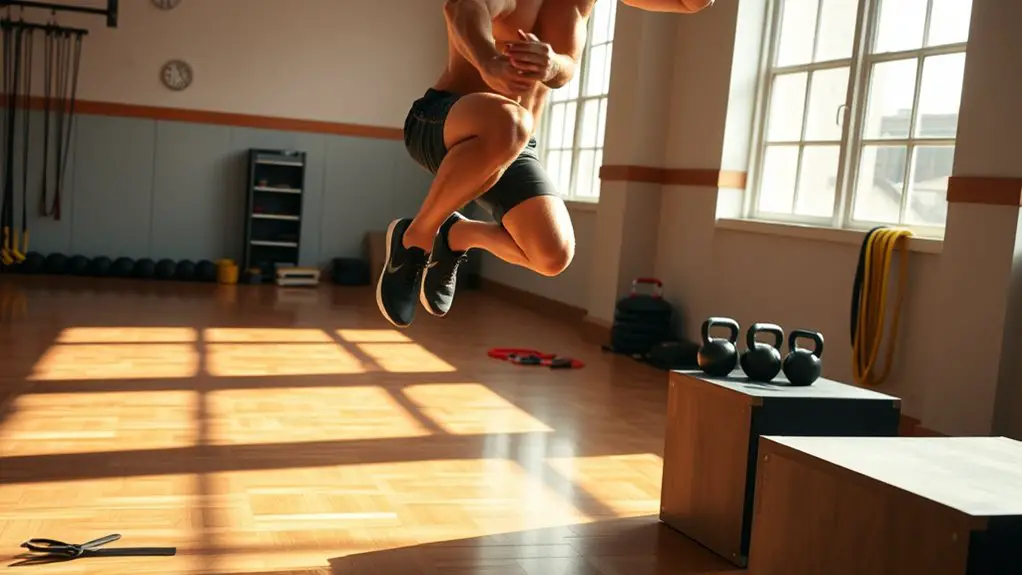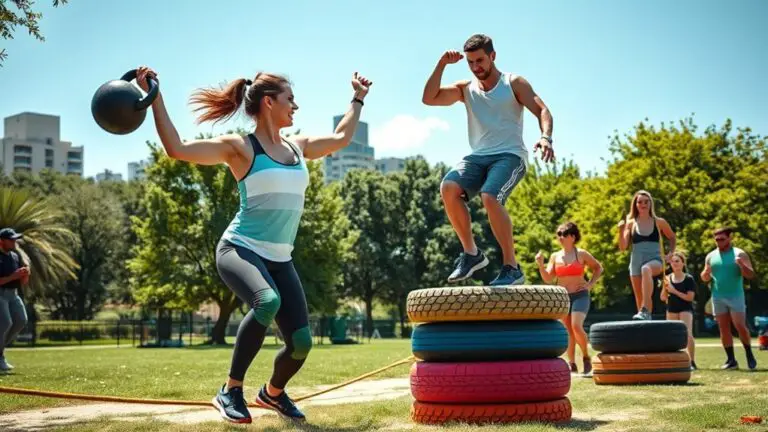Best Leg Workouts for Mass and Strength

To build mass and strength in your legs, combine compound exercises like barbell squats and deadlifts with isolation movements such as leg extensions and hamstring curls. Incorporate plyometrics, like box jumps, for explosive power. Don’t forget to adjust your workouts for progressive overload and guarantee you’re allowing for proper recovery with rest days. Finally, manage your nutrition with quality protein and hydration. There’s plenty more you can explore to maximize your leg development.
Compound Exercises for Maximum Muscle Growth

When it comes to building mass and strength in your legs, compound exercises should be at the forefront of your routine. Barbell squats are a fantastic choice, engaging multiple muscle groups while promoting overall stability. By ensuring proper form and starting with a manageable weight, you can minimize the risk of injury and maximize gains.
Deadlift variations, like sumo or conventional deadlifts, are equally effective for developing leg strength. These exercises not only target your hamstrings and glutes but also activate your core, enhancing overall balance. Always keep your back straight and your core tight to maintain safety while lifting.
Remember to gradually increase weights and listen to your body. Incorporating these compound movements into your regimen will help you build a solid foundation for leg strength, setting you up for success in more advanced exercises later on. Prioritize safety, and you’ll see progress in no time. Additionally, monitoring workout types is essential for ensuring that your leg training remains effective and aligned with your goals.
Isolation Movements to Target Specific Leg Muscles
While compound exercises lay a strong foundation for leg strength, isolation movements allow you to target specific muscles, ensuring balanced development. Adding leg extensions and hamstring curls to your routine can help you focus on the quadriceps and hamstrings, respectively.
Leg extensions primarily isolate the quadriceps, making them ideal for building strength and definition in the front of your thighs. When performing them, start with a light weight to avoid strain, and gradually increase as you gain confidence and stability.
Hamstring curls, on the other hand, focus on the back of your legs. They can be done seated or lying down, depending on your equipment. Remember to keep your movements controlled and avoid jerking motions to prevent injury. Incorporating these isolation exercises into your regimen will not only enhance your overall leg development but also improve your performance in compound lifts. Always prioritize form over weight for safety and effectiveness.
Plyometric Workouts for Explosive Power

To build explosive power in your legs, incorporating plyometric workouts into your routine is crucial. These exercises enhance your jump training ability and improve overall athletic performance. Always start with a proper warm-up to prevent injuries, and verify you have a clear space to work out safely.
Here’s a quick guide to effective plyometric workouts:
| Exercise | Description | Safety Tips |
|---|---|---|
| Box Jumps | Jump onto a sturdy box. | Use a box height you’re comfortable with. |
| Depth Jumps | Step off a box, then jump upon landing. | Focus on soft landings to reduce impact. |
| Broad Jumps | Jump forward as far as possible. | Keep your knees aligned over your toes. |
Incorporating speed drills with these exercises will further enhance your explosive power. Remember, prioritize form over speed to maximize benefits and minimize injury risk.
Incorporating Variations for Progressive Overload
Incorporating variations into your leg workouts is essential for achieving progressive overload, as it continually challenges your muscles and promotes growth. By using exercise modifications, you can target different muscle fibers and prevent plateaus. For instance, switching from barbell squats to goblet squats or incorporating single-leg variations can keep your routine fresh and effective.
Additionally, adjusting your training frequency plays a significant role in stimulating growth. If you’re consistently working your legs twice a week, consider alternating intensity levels or changing the number of sets and reps. This not only keeps your workouts engaging but also allows your muscles to adapt and grow stronger.
Always prioritize safety when trying new exercises or increasing weights. Pay attention to your form, and don’t hesitate to scale back if you feel uncomfortable. With the right balance of variation and frequency, you’ll be well on your way to building mass and strength in your legs.
Recovery and Nutrition Tips for Optimal Leg Development

Ideal leg development hinges not just on intense workouts but also on effective recovery and proper nutrition. To maximize your gains and guarantee your legs stay strong, follow these essential tips:
- Prioritize rest days: Allow your muscles to repair and grow; don’t skip them!
- Focus on nutrient timing: Consume a balance of carbs and protein post-workout to fuel recovery.
- Implement hydration strategies: Drink water regularly to support muscle function and prevent cramps.
- Choose quality protein sources: Incorporate lean meats, legumes, and dairy to aid muscle repair.
- Listen to your body: Pay attention to soreness and fatigue; adjust your routine as needed for safety.
Frequently Asked Questions
How Often Should I Train My Legs Each Week?
To determine how often you should train your legs each week, consider your training frequency alongside leg recovery. Most people find training legs 1-3 times a week works well, but listen to your body. If you’re feeling fatigued or sore, it’s crucial to allow enough recovery time. Balancing intensity with rest guarantees you’re not overtraining, which can lead to injury. Prioritize safety and adjust your schedule as needed for best results.
What Are the Best Leg Exercises for Beginners?
If you’re just starting out, bodyweight squats are a fantastic exercise to build strength and stability. They’re safe and can be done anywhere. You might also want to incorporate resistance bands into your routine; they add extra tension without risking injury. Try performing both exercises with proper form, focusing on slow and controlled movements. It’ll help you develop a solid foundation for your leg workouts as you progress.
How Do I Prevent Leg Injuries During Workouts?
How can you guarantee you stay injury-free during leg workouts? It’s vital to focus on a proper warm-up to get your muscles ready. Don’t skip mobility drills, as they enhance flexibility and range of motion, reducing injury risk. Always listen to your body; if something doesn’t feel right, it’s okay to take a step back. Prioritize safety, and with the right approach, you can enjoy your workouts while minimizing injuries.
Should I Prioritize Strength or Hypertrophy for Leg Training?
When deciding between strength vs hypertrophy, think about your training goals. If you’re aiming for overall power and functional strength, prioritize strength training. However, if you want to increase muscle size, focus on hypertrophy. It’s crucial to strike a balance to prevent injuries; incorporating both styles can lead to better overall development. Remember to listen to your body, adjust your intensity, and guarantee your form’s correct to stay safe during your workouts.
Can I Train Legs at Home Without Equipment?
Absolutely, you can train your legs at home without equipment! With bodyweight exercises like squats, lunges, and calf raises, you’ll build strength safely and effectively. Consider crafting dynamic home routines that challenge your muscles while keeping you injury-free. It’s all about consistency and form, so focus on controlled movements. Embrace the freedom of at-home workouts, and enjoy the journey of sculpting your legs with simple yet powerful exercises!





